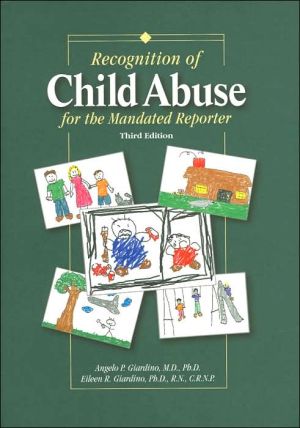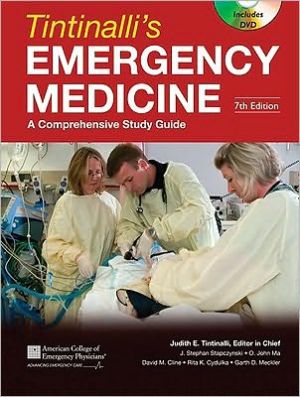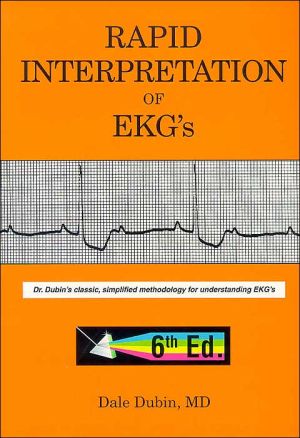Recognition of Child Abuse for the Mandated Reporter
Completely updated, this widely acclaimed practicalreference helps professionals fulfill their legal and ethical responsibilities to report child abuse with a high level of confidence, effectiveness and gratification. The book also serves as a textbook for students in medicine, nursing, social services, and law enforcement who are preparing for work with children. Written by experts from multiple disciplines, "Recognition of Child Abuse for the Mandated Reporter" incorporates proven...
Search in google:
Provides the information necessary to help mandated reporters recognize child maltreatment, identify those children who are at high risk for abuse & neglect and realize strategies for preventing and intervening in abuse situations. Doody Review Services Reviewer:Gretchen Anne Overstolz, MSN(Children's Medical Assessment Center)Description:This is a basic overview of child maltreatment for healthcare providers, teachers, and law enforcement and other professionals who may come into contact with abuse victims during their daily working lives, and are by law required to report incidents of abuse. This book gives general information regarding signs and symptoms of abuse, as well as some of the current risks to children, such as misuse of the Internet and increased school violence. It also gives a general overview of the current systems of response. Purpose:The purpose, according to the authors, is to provide current, practical information to help professionals recognize the signs and symptoms of abuse. It is to be used as a textbook for education of professionals. Additionally, the authors claim to incorporate proven approaches for evaluating possible abuse. Although this book provides a very nice overview of child maltreatment, it does not provide enough accurate information to warrant its use as a reliable source for the evaluation and documentation of child maltreatment. Audience:According to the authors, this book is written for all professionals who deal with children or possible allegations/symptoms of abuse. I agree that this book is a very broad overview for a general population of professionals who may come into contact with child vicitms of abuse and want to know more about it. Features:This book covers basic information regarding signs and symptoms of physical, sexual, and emotional child maltreatment and neglect. It reviews the process that should take place when abuse is suspected. It also gives an overview of strategies that are in place for dealing with abuse and treatment, as well as prevention. It is a very good reference for those who work with children. This book does not, however, provide adequate information for professionals to use in the actual evaluation, investigation, or treatment of child abuse. At least one of the photographs and explanations (page 29, fig 2-3-b) is inaccurate, using incorrect terminology for the finding. (This is a full thickness hymenal transection as opposed to a "cleft".) Genital examinations can be extremely subjective and it is important for readers to understand that this book does not provide enough information for healthcare providers to use in the medical evaluation of sexual abuse. Testing for sexually transmitted diseases of children can differ from adult testing, and the reliability of certain adult STD tests for children is questionable. It would be impossible to cover such issues in such a generalized text. This book is also limited in its coverage of findings that can be mistaken for abuse. Additionally, this book does not cover domestic violence, which current research shows is a leading risk factor in child maltreatment. Signs of and response to domestic violence in families is probably one of the most important areas of needed awareness for reporters. Assessment:This is a good overview. If used in didactic education for teachers, social workers, and medical professionals, awareness of the problem can generally be raised. This book is on the same scale as other such overviews such as Handbook for Child Protection Practice by Dubowitz and Depanfilis (Sage Publications, 2001) and APSAC Handbook on Child Maltreatment, 2nd Edition, by Myers et al. (Sage Publications, 2002). However, it is not on the same scale as books that are used for training and education of evaluators and investigators of abuse. It is written in an easy to understand manner, and it is interesting to read. It is a welcome overview for raising awareness for nonspecialists.
Ch. 1Physical Abuse1Ch. 2Sexual Abuse23Ch. 3Child Neglect and Abandonment39Ch. 4Educational Neglect55Ch. 5Psychological Abuse63Ch. 6Munchausen Syndrome by Proxy93Ch. 7Violence Among Children109Ch. 8Psychological and Psychiatric Issues137Ch. 9To Report or Not to Report: Is That The Only Question? Child Maltreatment and Social Work Responsibilities in Acute Healthcare Settings157Ch. 10The Role of the Schools in Child Abuse175Ch. 11Art Therapy227Ch. 12The Internet and the Risk for Maltreatment259Ch. 13The Role of Law Enforcement in the Investigation of Child Maltreatment279Ch. 14Legal Issues309Ch. 15After the Call: Children and the Child Welfare System: Community and In-Home Services or Out-of-Home Placement351Ch. 16Prevention Efforts: Local379Ch. 17Prevention Efforts: National393App. A: Professional Resources407App. BState Toll-Free Child Abuse Reporting Numbers417
\ Reviewer: Gretchen Anne Overstolz, MSN(Children's Medical Assessment Center)\ Description: This is a basic overview of child maltreatment for healthcare providers, teachers, and law enforcement and other professionals who may come into contact with abuse victims during their daily working lives, and are by law required to report incidents of abuse. This book gives general information regarding signs and symptoms of abuse, as well as some of the current risks to children, such as misuse of the Internet and increased school violence. It also gives a general overview of the current systems of response. \ Purpose: The purpose, according to the authors, is to provide current, practical information to help professionals recognize the signs and symptoms of abuse. It is to be used as a textbook for education of professionals. Additionally, the authors claim to incorporate proven approaches for evaluating possible abuse. Although this book provides a very nice overview of child maltreatment, it does not provide enough accurate information to warrant its use as a reliable source for the evaluation and documentation of child maltreatment. \ Audience: According to the authors, this book is written for all professionals who deal with children or possible allegations/symptoms of abuse. I agree that this book is a very broad overview for a general population of professionals who may come into contact with child vicitms of abuse and want to know more about it. \ Features: This book covers basic information regarding signs and symptoms of physical, sexual, and emotional child maltreatment and neglect. It reviews the process that should take place when abuse is suspected. It also gives an overview of strategies that are in place for dealing with abuse and treatment, as well as prevention. It is a very good reference for those who work with children. This book does not, however, provide adequate information for professionals to use in the actual evaluation, investigation, or treatment of child abuse. At least one of the photographs and explanations (page 29, fig 2-3-b) is inaccurate, using incorrect terminology for the finding. (This is a full thickness hymenal transection as opposed to a "cleft".) Genital examinations can be extremely subjective and it is important for readers to understand that this book does not provide enough information for healthcare providers to use in the medical evaluation of sexual abuse. Testing for sexually transmitted diseases of children can differ from adult testing, and the reliability of certain adult STD tests for children is questionable. It would be impossible to cover such issues in such a generalized text. This book is also limited in its coverage of findings that can be mistaken for abuse. Additionally, this book does not cover domestic violence, which current research shows is a leading risk factor in child maltreatment. Signs of and response to domestic violence in families is probably one of the most important areas of needed awareness for reporters. \ Assessment: This is a good overview. If used in didactic education for teachers, social workers, and medical professionals, awareness of the problem can generally be raised. This book is on the same scale as other such overviews such as Handbook for Child Protection Practice by Dubowitz and Depanfilis (Sage Publications, 2001) and APSAC Handbook on Child Maltreatment, 2nd Edition, by Myers et al. (Sage Publications, 2002). However, it is not on the same scale as books that are used for training and education of evaluators and investigators of abuse. It is written in an easy to understand manner, and it is interesting to read. It is a welcome overview for raising awareness for nonspecialists.\ \ \ 3 Stars from Doody\ \








